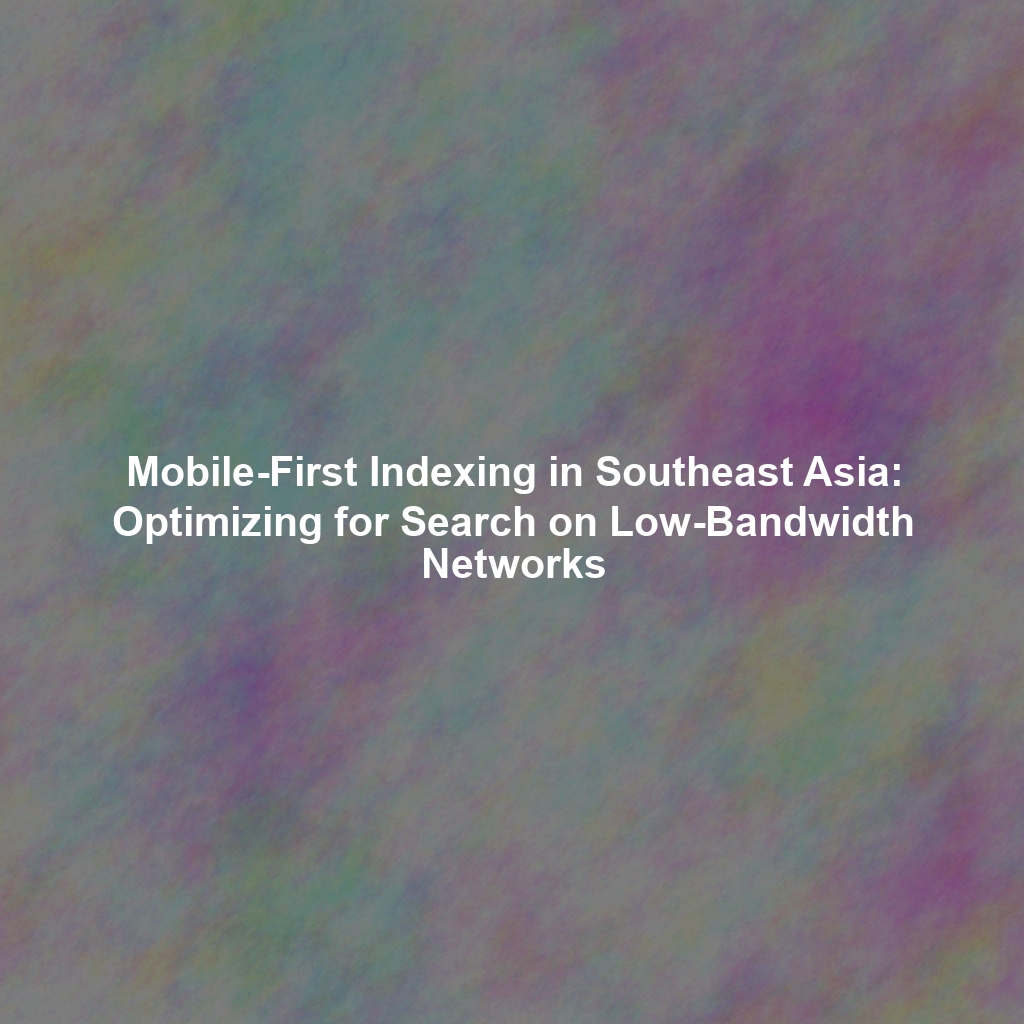Southeast Asia is a mobile-first powerhouse. For many in this region, the smartphone isn’t just a gadget; it’s the primary gateway to the internet. This reality makes understanding and adapting to Google’s mobile-first indexing absolutely crucial for any business targeting this vibrant market. However, a significant challenge exists: the prevalence of low-bandwidth networks. This article will explore the intricacies of mobile-first indexing in Southeast Asia, focusing on strategies to optimize your website for slower connections, thereby boosting search visibility and enhancing user experience.
Understanding Mobile-First Indexing and Its Impact in Southeast Asia
Mobile-first indexing simply means that Google primarily uses the mobile version of a website for indexing and ranking. Historically, Google crawled the desktop version of a site. Now, the mobile version takes precedence. This shift is driven by the fact that most users now access the internet through mobile devices.
In Southeast Asia, this is even more significant. Countries like Indonesia, the Philippines, and Vietnam have incredibly high mobile penetration rates. Ignoring mobile optimization is akin to ignoring a massive segment of your target audience. Failure to adapt will lead to:
- Lower Search Rankings: Google will penalize websites that aren’t mobile-friendly.
- Reduced Visibility: Your website will appear less often in search results for mobile users.
- Poor User Experience: Slow loading times and a clunky mobile experience will drive visitors away.
The Low-Bandwidth Challenge: Optimizing for Speed and Performance
While smartphone adoption is high, reliable, high-speed internet access is not always guaranteed across Southeast Asia. Many users rely on 3G or even 2G connections. This presents a unique challenge for website owners. Here’s how to tackle it:
Prioritize Website Speed
Website speed is critical for user experience and search ranking, especially on low-bandwidth networks. Here’s how to improve it:
- Optimize Images: Compress images without sacrificing too much quality. Use formats like WebP, which offer superior compression.
- Minify Code: Reduce the size of your HTML, CSS, and JavaScript files by removing unnecessary characters and whitespace.
- Leverage Browser Caching: Allow browsers to store static assets locally, reducing the need to download them repeatedly.
- Enable Gzip Compression: Compress files before sending them to the browser.
- Reduce HTTP Requests: Minimize the number of elements your website needs to load. Combine CSS and JavaScript files where possible.
Choosing the Right Content Delivery Network (CDN)
A CDN stores copies of your website’s content on servers around the world. When a user visits your site, the CDN delivers the content from the server closest to them, reducing latency and improving loading speed. When choosing a CDN for Southeast Asia, consider:
- Server Locations: Ensure the CDN has servers located in key Southeast Asian countries like Singapore, Indonesia, and Thailand.
- Regional Performance: Research which CDNs perform best in the region. Some CDNs may have better infrastructure in certain areas.
- Pricing: Compare pricing plans and choose one that fits your budget and traffic volume.
Popular CDN providers with strong presence in Southeast Asia include Cloudflare, Akamai, and Amazon CloudFront. Consider local CDN providers as well, as they might offer better performance within the region.
Accelerated Mobile Pages (AMP)
AMP is an open-source HTML framework that allows you to create lightweight, fast-loading mobile pages. AMP pages are often prioritized in Google’s search results, especially in the “Top Stories” carousel. Implementing AMP can significantly improve your mobile visibility and user experience in Southeast Asia.
Progressive Web Apps (PWAs)
PWAs are web applications that offer a native app-like experience. They can load instantly, work offline, and send push notifications. PWAs are a great option for delivering a fast and engaging mobile experience, even on low-bandwidth networks.
Mobile-Specific Keyword Targeting
Understanding how users search on mobile devices is crucial for effective SEO. Consider these strategies:
Prioritize Long-Tail Keywords
Mobile users often use more specific and conversational search queries. Target long-tail keywords that reflect these search patterns. For example, instead of “cheap hotels,” target “cheap hotels near me with free wifi.”
Focus on Local SEO
Mobile searches are often location-based. Optimize your Google My Business listing and use local keywords in your website content to attract nearby customers.
Consider Voice Search
Voice search is increasingly popular on mobile devices. Optimize your content for voice queries by using natural language and answering common questions directly.
Analyze Mobile Search Trends
Use tools like Google Trends to identify trending mobile search queries in Southeast Asia. This will help you identify relevant keywords and topics to target.
Conclusion
Mobile-first indexing presents both challenges and opportunities for businesses targeting Southeast Asia. By understanding the nuances of the region, particularly the prevalence of low-bandwidth networks, and implementing the strategies outlined above, you can optimize your website for mobile search, enhance user experience, and achieve significant gains in visibility and traffic. Prioritizing website speed, choosing the right CDN, and targeting mobile-specific keywords are essential steps towards success in this dynamic and rapidly growing market. Remember that continuous monitoring and adaptation are key to staying ahead in the ever-evolving landscape of mobile SEO.
 Skip to content
Skip to content

